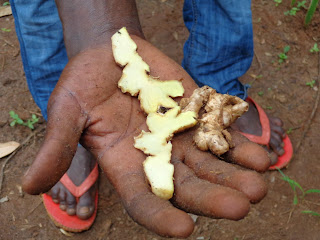We started out looking by at the red mahogany and teak trees on the Spice Farm, which grow very slowly. Their wood used to be a major export from Zanzibar, although these days the market is dominated by larger countries such as Indonesia. Now, it is forbidden to export these beautiful woods, although you can buy ready-made furniture and wooden goods to carry out of Zanzibar. It was interesting to see how patient the farmer needs to be to plant such trees- it can take up to 30 years before a tree can be cut and used. We then moved on with our guide to see products that grow much faster and can be harvested far more frequently....
Our fruit and spices tour began at this Jack Fruit tree, bearing these enormous fruits with their furry exterior...
The juicy Jack Fruit was tasty to try, with a taste that seems to be a cross between a pineapple and a banana...
Moving on to the Pepper Tree:
The peppercorns can be dried or harvested early to provide no less than 5 different types of pepper! If dried out, the pepper-corns below become the dark, black peppercorns we use to grind in a pepper-mill:
Fresh cloves:
My favourite tree is pictured here- the tree with cocoa pods...
...once the pod is opened, it is possible to extract the beans which are used to make CHOCOLATE!!!!! I'm so glad that people long ago made this fantastic discovery!! :-)
The tree below is a Cinnamon Tree:
The bark is the most useful part. If you cut the bark horizontally, you ruin the tree. If you cut it vertically, it provides strips of bark that can be dried out and rolled into cinnamon sticks or ground into cinnamon powder for cooking!
We saw a bush which bears the leaves that are ground down to make curry powder. Even the fresh, green leaves smell of curry! Take a sniff, close your eyes and you are transported to a curry-house full of delicious-smelling curry!
This is cardamon, which is extracted from the roots of a small bush:
The tree below amazed me. Even though I did a Spice Tour 11 years ago, I do not remember seeing this tree. It is the tree that produces iodine! Our guide slashed it with a knife and the red iodine splashed out like blood from a wound:
When you touch this red liquid and rub it into your skin, it transforms itself into a white balm, looking just like antiseptic lotion. Traditionally, it is used for natural healing in African culture. These days it is also commercially harvested and mixed in factories with certain chemicals to make the iodine we have on our pharmacy shelves.
The beautiful sight below is nutmeg, nestled into its seed pod and covered by a protective red substance:
The red layer can be pulled off like string. It feels like plastic and is used to make a component of pepper-spray: a self-defence product. The nutmeg itself can then be removed and is sold separately. Traditionally, nutmeg is favoured by women in East African cultures, as it can be boiled up as a somewhat potent brew to help them lose their inhibitions and join in tribal dancing! Don't worry- we weren't given any of the brew, nor the secret recipe!
The children all loved the citronella scent of the fresh lemon-grass:
Here, Ben is standing by the shrub that produces ginger:
The root is dug up to provide ginger, which tastes extremely strong when it is fresh from the ground!
Vanilla pods:
Pineapples grown on the farm:
The seeds below come from a bush grown for the tandoori colouring which the ground-up seeds produce. Next time you have a tandoori chicken dinner, you can picture the seed-pod in Zanzibar where your sauce originated!
Along the way, we were all decorated with banana-leaf adornments- a necklace for me, watches for the children, baskets for Esther and Ben and a fetching tie for Andrew:
Some fruits were localised, like the Zanzibar apple Andrew is tucking into. Not my favourite fruit, but very popular with Esther!
At the end of the tour, we all sat down to a Spice Lunch, cooked by the villagers whilst we had been touring the farm:
It was a delicious lunch, with chapati, slightly curried "pilau" rice, vegetables in sauce made from freshly-cut coconut and with cloves and spices added. Sitting down for this lovely lunch enhanced our enjoyment of the local produce we had been learning about that morning. A mouth-watering, spicy end to a wonderful, spicy tour!
























Your trip to Zanzibar sounds fantastic and it's lovely to see you all enjoying yourselves in the photos. I had no idea Zanzibar produced so many of the things we so easily pick up in Tesco! Much nicer when they are fresh though I'm sure! Love Wendy x
ReplyDeleteWhat amazing experiences of life Esther Ben and Joel are receiving in their little lives, so many sights and adventures some of us old aarlies have never had. love nana
ReplyDeleteWhat an amazing place to see, these are experiences the children will never forget. Just can't imagine all those different trees in one place.
ReplyDeleteThink of you often you are always in our prayers
love
Pauline & John